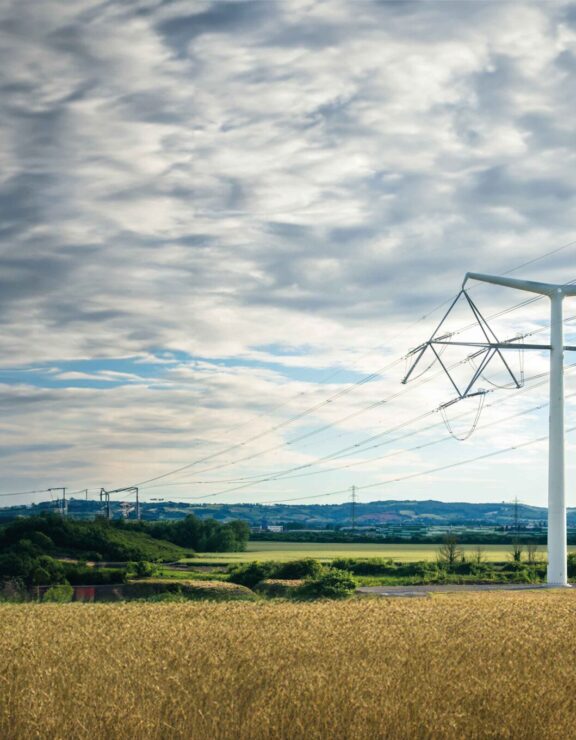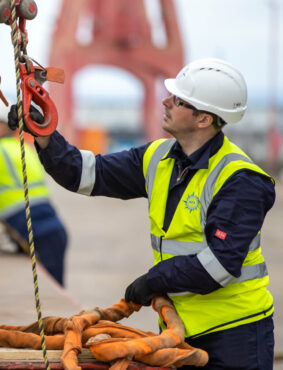
Hinkley Point C: T-pylon Collection Project
Overview
Hinkley Point C power station in the South West of England is a major new initiative from National Grid to supply 6 million homes and businesses in the region with home-grown low-carbon energy as part of the UK’s efforts to reach net-zero by 2050.
To support the network, 116 pylons of a new, unique design were commissioned. Our initial discussions with our logistics partner at origin and the principal contractor Balfour Beatty involved simply handling the discharge and storage of the first (South) phase of 48 T-pylons at the UK port of Avonmouth. However, as the scenario developed, we were then asked to handle transportation logistics for the components all the way to the locations for installation – hiring cranes, marshalling the many pylon parts in a yard and organising the trucking to each individual site.
After starting transportation of the South phase and successfully showing our capabilities, we were then also awarded the larger North phase – delivering the infrastructure for the full 57-kilometre pylon route.
Challenge
Understanding the clients’ requirements and translating them into a logistics reality was a complex task involving a detailed schedule of items, with close attention to each manifest and what would need to be stored or lifted out for each consignment.
Transportation from China was by breakbulk charter vessels (2 per phase), with cargo stowed loose in the ships’ hold. Components would be taken off and sorted separately into their ongoing sets to be taken to the location while still in port.
The complication was that almost every site was unique. We immediately started to assess the challenges of coordinating the numerous pylon pieces to make sure each individual location received the correct parts for construction. As shipments arrived at Avonmouth, our projects team went on site to oversee the discharge of the cargo.
We had to navigate the challenge of cargo discharge very carefully to achieve the end result we wanted for our clients. Ships want to be in and out as quickly as possible and will have their own preconceived plans for discharge – and the port themselves will also have ideas for their resources and labour. Over the course of time, we built on our existing relationships with the port staff – from management to the crews on the ground and storage yard operatives – to make sure everything was coordinated, synchronised and moving along at the speed we needed.
What they said
Delivery
The ships were loaded in China for maximum possible efficiency in terms of space, but we didn’t know the stowage plan of the vessel until a week before it arrived. We had a short space of time to organise how we offloaded and stored the cargo in such a way that we were able to efficiently get the pylon pieces back out of storage and delivered directly to the sites for the end customer.
As each piece came off the vessel, our lead project manager worked with our port contracts to create a storage plan for the yard so that components were easy to reach for delivery to site. We also went with the trucking company to the locations themselves to scope out the restrictions trucks would face negotiating narrow country lanes, tight gaps through walls and ‘haul roads’ across fields to their final destinations.
In addition to these complexities, we had days when the wind was too strong for cranes to operate, and occasions when pylon foundations needed more groundwork. With each new challenge, we quickly rearranged plans to send different pieces to different sites to keep the project on schedule.
The South Phase’s two shipments were delivered in a very short time frame, requiring an intense amount of trucks and labour, and many working weekends. This continued with the larger North phase of the project, when shipping line complications meant they wanted the next two vessels to arrive at the same time. Something that wasn’t practical for the port.
Not keeping pace with a shipping line’s schedule can lead to vessel detention rates of potentially $20-30,000 a day. By being on the ground at the port and negotiating with the port management, the shipping line agent and the ships’ captains, we managed to get a practical solution that satisfied all parties.
Everyone involved at Avonmouth port performed exceptionally. Crews took rolling breaks to enable continual unloading during 12-hour day shifts, weekday and weekend, to make sure we got the first vessel unloaded within four days before the next ship arrived straight after it. Our project lead was even there on the quay, chipping in to help crews hook and unhook the cargo, strap it down onto the trailers and stay in contact with the storage yard to make sure strong communication was upheld and the operation stayed on track.
After a continuous 8-day unloading operation, balancing the needs, requests and ideas of the port, the shipping line and the clients – and coming up with practical plans of how to make everything work – we had the entire operation on an even keel.
Results
With components now in the UK, stored efficiently and continually being trucked out their locations, operations regained a more manageable pace. However, the complications due to winds, extra groundwork on foundations and the process of installing pylons in protected areas meant we were constantly revising our plans, sometimes on a day-to-day basis.
The ability to think on our feet was greatly honed and showcased throughout this project until the final components were delivered in mid-May 2023, marking the culmination of a 3-year exercise in painstaking overland logistics.
The greatest result is without doubt the strength of ongoing relationships with key players in both the UK port system and the nation’s power supply infrastructure, as well as the successful supply of pylons to ensure a robust, low-carbon power supply for the South West for decades to come.







